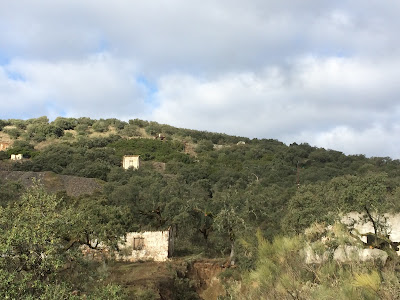During these winter holidays, I returned to
visit my friends in Burguillos del Cerro. One of the highlights of my visit was
a trek to the Monchi Mines. At the invitation of Antonio Surribas, Antonio
Requejo and I went along with him and his son Antonio II.
The entrance to the mines has caved in and we had to go in through a narrow entrance. Once in there, we could see an old iron cart used to carry the iron ore. I also saw a hard hat and other tools left behind. Then, the impressive ore illuminated our surroundings once we shone the light on it. There were several passageways and we came across a couple of lonely bats resting on the stones. From what Antonio Requejo mentioned, there were colonies of them a couple of months before we visited. However, on this visit, there were only a few different species scattered about. Further along we could see indentations on the walls and even holes that were made for placement of dynamite sticks. As we walked along the passageways, there were extensions to other areas of the mine, but we did not venture in them due to safety reasons. As we came upon a large open area, there was a sort of lift that used to take the workers to different levels of the mines. What was very amazing and exciting for me to see were the different layers of minerals. In one of the areas, we could even see the formation of stalactites starting to take shape. We finally came upon a circular pit that had steps which extended upwards and was used as an emergency exit in case of a cave in. It was quite necessary in those times and very impressive. We spent about an hour at Monchi before making our way out.
The entrance to the mines has caved in and we had to go in through a narrow entrance. Once in there, we could see an old iron cart used to carry the iron ore. I also saw a hard hat and other tools left behind. Then, the impressive ore illuminated our surroundings once we shone the light on it. There were several passageways and we came across a couple of lonely bats resting on the stones. From what Antonio Requejo mentioned, there were colonies of them a couple of months before we visited. However, on this visit, there were only a few different species scattered about. Further along we could see indentations on the walls and even holes that were made for placement of dynamite sticks. As we walked along the passageways, there were extensions to other areas of the mine, but we did not venture in them due to safety reasons. As we came upon a large open area, there was a sort of lift that used to take the workers to different levels of the mines. What was very amazing and exciting for me to see were the different layers of minerals. In one of the areas, we could even see the formation of stalactites starting to take shape. We finally came upon a circular pit that had steps which extended upwards and was used as an emergency exit in case of a cave in. It was quite necessary in those times and very impressive. We spent about an hour at Monchi before making our way out.
The Monchi is a magnetite mine. From what I
have found out, it is one of the best mines in
Spain due to its varied mineral and geological content; some of the most common are pyrite,
hematite, calcite and sulfur among the iron.
The mines have been around since before the Romans
were in Spain. In fact, the Romans were known to have mined around the area
near Jerez de los Caballeros, close to Burguillos.
One of the interesting things I found out
when I was inside the mines was that the GPS in my mobile indicated I was in
Jerez de los Caballeros as we went further in. Could these have been the same mines that the
Romans also excavated?
As history tells us, the Monchi mines were in use during the 19th
century up until the late 1800’s.
Later, in the 1950’s, it became a working
mine again that contributed to the population boom of Burguillos with an increase
of a couple of thousand more inhabitants.
The mines finally closed in 1978.
In the near future, the mines of Monchi are
set to open as a tourist and research attraction of the city of Burguillos del
Cerro.
An interesting document I found with more
information on the mine, can be found here: http://extremambiente.gobex.es/files/biblioteca_digital/patrimonio_2010/Patrimonio%203.18.pdf
The
document is in Spanish.






